Kagrra,'s new single, the extremely long-winded and traditional "Tsuki ni Murakumo Hana ni Ame" (with bonus "silent" kanji!) is due out the 16th. The single itself is a much quicker pace than their last single, with a light beat befitting of its summer release. The B-side I've heard on the main version is startlingly similar to old-school, "Matsuri"-era Kagrra,, as is the PV for "Tsuki ni Murakumo Hana ni Ame" itself, which bears resemblance to their most Visual of PVs, "Yume Izuru Chi", and one of their more popular photoshoots, as Isshi goes and gets his xxxHoLic on in the video with a kiseru, calligraphy, and onmyoji markings on his hands. Kagrra, really went all-out with the costumes for this one, with a very modern style mixed in with even more vibrant traditional couture. It's really refreshing for a Visual band to become more Visual, or consistently remain as flamboyantly earnest as they have been since they began, and the PV has many cool elements that you really have to see, rather than just me describing them. Keeping consistent on this theme, the single to be released after this one has also been announced, and it promises to be just as confusing and abusive to me when it comes to the characters used for the title and, most likely, the lyrics as well. Obsolete character count so far: many. Maybe I'll do an entry on it when it comes out, we'll see. But anyway, this release seems like it's going to be a great one, so I highly recommend that you check it out and, if possible, please support the band by purchasing it!
But enough shameless promotion. Let's delve into another new thing Kagrra, is pursuing, and get a bit more insight on the band, the members, and traditional (obscure) old cultural facts about Japan.
This entry was supposed to be about the numerous yōkai that have been featured in Kagrra, videos, songs, interviews, etc. over the years. For a yōkai-loving band that's been around for over a decade, there were obviously quite a few to choose from. Luckily (for you, unluckily for me), Kagrra, had the very same idea, and decided to honour their 10th Anniversary with PSC tour with even more yōkai to torment me with.
The idea in itself is pretty ingenious, and well-suited to Kagrra,. The 10th Anniversary tour takes place nationwide across Japan, and the "wandering" of the band from one location to another across the country inspired them to title the tour after one of their very first songs, "Hyakkiyakou", which not only brings the whole thing together, but, as you'll recall here, encapsulates the point of the tour and the point of Kagrra, the demons making their march each night. Also included in the tour's name, the kanji for "tour" also has the double-meaning of "pilgrimage", reinforcing that fact, as well as another kanji alluding to "the other side". So with that, each stop in the tour is named after a yōkai from the area in which the band is performing. This summons images and stories invoked by the many yōkai undoubtedly learned of by Isshi and Izumi's recent tours and events inviting people all across Japan to submit local folklore and legends of ghosts, yōkai and other such bakemono (monsterous creatures or things) from all over the country. This has lead to the performances alternatively honouring the most famous of yōkai, and, like the kanji, the most frustratingly obscure. Thanks a lot, Isshi.
If you missed the last entry, make sure to check it out, because it contains a lot of information explaining yōkai, their popularity, and their purpose. Many of them have ties to the ones I'll discuss in this one as well, so follow the link here if you're interested.
So, let's get started, shall we?
The very first stop on Kagrra,'s Hyakkiyakou is, appropriately enough, named after the most famous yōkai of all, the Kappa (河童). Literally meaning "river child", as amphibious, sprite-like creatures, Kappa are roughly child-sized and lurk near the water's edge (generally rivers, ponds, swamps, or other freshwater locales).

Sekien's Kappa.
The Kappa is so well known partly because of its fearsome prowess. Almost all children will hear about being careful near the water or not wandering out of sight because "a Kappa will drag you into the water and eat you". The Kappa is usually depicted resembling a frog, with webbed hands and feet, scaly green or brown skin, although it is large and human-shaped, and it walks on land with two legs. Occasionally possessing a beak or turtle shell, most notable is the indentation on the top of the Kappa's head.
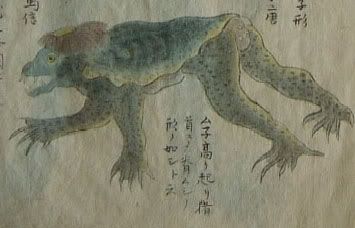

Sometimes shown as a lily-pad hat or growth, often surrounded by a mess of tangled, seaweed-like hair, this indentation holds a small dish or bubble of water from the Kappa's chosen residence. This is the Kappa's life essence, and without it the Kappa will either die or be forced to return to the water. Despite their penchant for being frightening river-dwelling child murderers, mostly Kappa are viewed, like the kitsune or tanuki, as a mischievous yōkai, who will help you if you are drowning, or are a farmer and need more water on your land, or for luck. Kappa are known for enjoying sumo wrestling, and often challenging people to a match. If a Kappa becomes angry and aggressive, superstition denotes that, if you accept his challenge to wrestle, you must bow before the match out of honour, so if you bow very deeply, or do so on a hot day, the Kappa's head-depression full of water will dry up and spill over, which will force him to run away and be unable to kidnap you.

A statue of a Kappa.
Kappa are also well-known for their toilet humour. Kappa love to feed on people because of their most favourite meal, the Shirikodama, a type of organ or essence apparently located somewhere inside the human anus. It is said that, once the Kappa pulls you into the water, it will use its webbed hands to retrieve the Shirikodama from you. Kappa themselves are thought to have a number of anuses. And in this extremely famous work by Yoshitoshi, a person is able to drive Kappa away by propelling a fart at them.
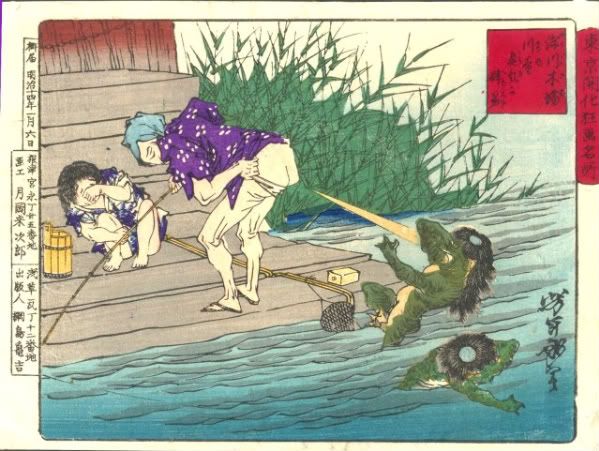
Yep.
Culturally, there are so many words, phrases, legends and customs associated with the Kappa that I could do an entire entry on them alone. But I guess the one thing I definitely have to mention is the Kappa's favourite food (besides the contents of someone's behind) is the cucumber. Kappa are notoriously known for their love of cucumbers, and will befriend you and be a help to you in exchange for some. At the very least, they won't assault your backside. One of the most common sushi rolls is called kappa maki in honour of the creature, a simple roll filled with cucumber.
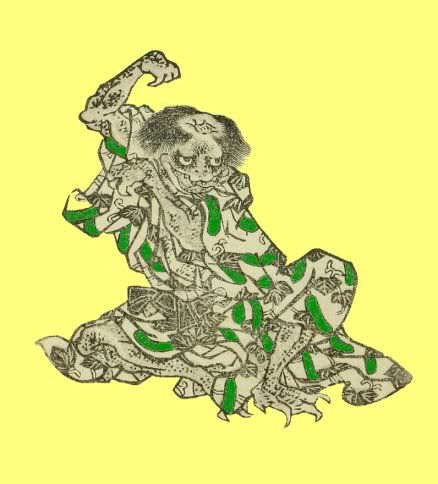
In a print by Kunisada, this Kappa even got himself a kimono to wear with a pattern of cucumbers.
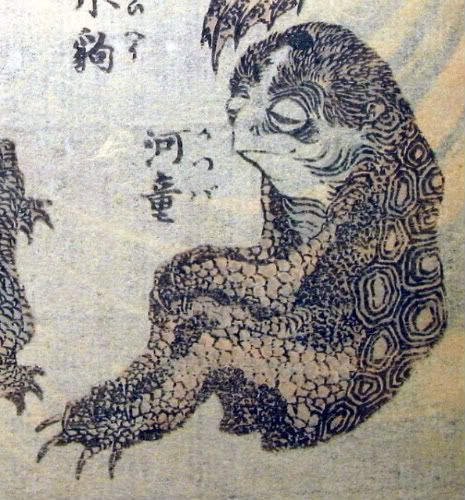
Hokusai's Kappa.
The next stop on the magical mystery tour is named in honour of the Nue (鵺), a composite monster likened to a chimera. The name, which is taken to mean "fantastical creature", is made up of the following: the face of a monkey (or sometimes a cat or even a chicken), the body of a raccoon (sometimes a fox), the legs of a tiger (with the tiger markings occasionally present on the raccoon torso), and the tail of a serpent (backwards with the snake's head on the tip).
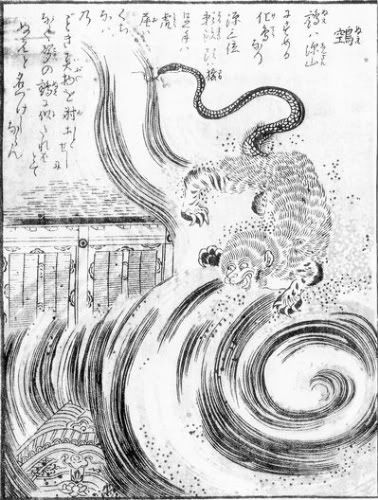
Sekien's Nue.
The Nue story actually predates Sekien's yōkai entry, and most yōkai in general, by being traced all the way back to the Heike Monogatari, a circa 1200s epic work describing the events of a war surrounding the famous Heian period clans, the Taira and Minamoto. Naturally, this has been adapted countless times in Noh and kabuki, and the story goes as follows:
The Emperor at the time, Konoe-tenno, was being plagued with repetitive nightmares each evening, and became increasingly of poorer health, driven near mad with illness. A notable warrior, Minamoto no Yorimasa, soon noticed that a black cloud would form and float over the palace each night as the Emperor was faced with yet another nightmare and waning health. It seems that Nue are able to travel on these stormy clouds, and move about the sky in order to cause illness and insanity in their victims.
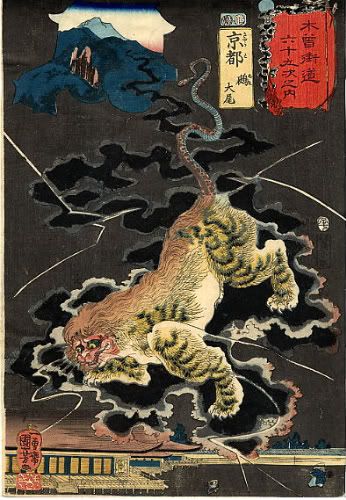
It is seen here in a work by Kuniyoshi.
Pretty scary stuff.
After witnessing this evil cloud manifestation, Minamoto no Yorimasa went to the roof of the palace one night and waited for the cloud to form once again. As the cloud drew nearer, he heard an eerie, haunting call within the mist, which has come to be associated as the cry of the Nue. Interestingly enough, this call is thought to be from a type of thrush bird, which at this period historically was called "nuye" or "nue", though the word now refers to this beast. Anyway, Minamoto no Yorimasa took out his bow and arrow and fired at the cloud directly in the place he heard the cry, and from the spot fell the Nue monster.
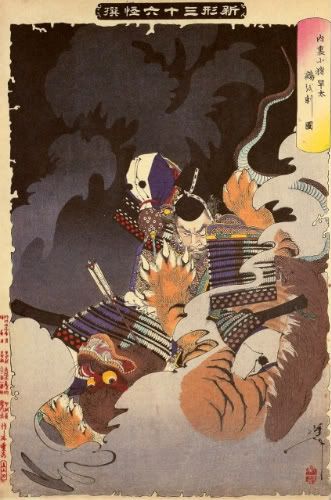
In this ukiyo-e by Yoshitoshi, he fights the fallen Nue.
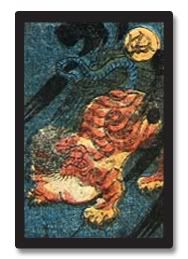
In the Obake Karuta, Nue represents "nu".
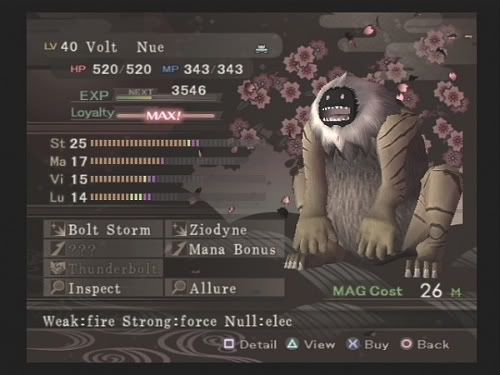
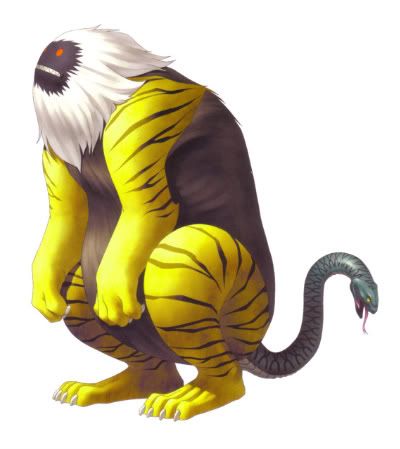
The Nue as it appears in Devil Summoner.
It is also worth mentioning that Kagrra, has an album entitled "Nue", with a song as well entitled "Nue no Naku Koro" ("When the Nue Cries"), which features some of their most interesting and unsettling lyrics.

A real-live stuffed Nue! Sort of.
The next location Kagrra, travels to is Sapporo, where the yōkai is not quite a yōkai at all, but a creature from Ainu legend. Sapporo is the capital of Hokkaido, the northernmost part of Japan, and this island and the area surrounding (including Russia) is home to the Ainu people, an indigenous tribe home to some of the most beautiful (and terrifying) customs, fascinating mythology, and engrossing history and language that is extremely fun to experience. So for this stop, the event is named for the legendary figures known as the Korpokkur (コロポックル).
Taken from the words meaning "the people under the fuki leaves", Korpokkur were known as tiny dwarf or gnome-like creatures that lived below the leaves of the fuki plant.
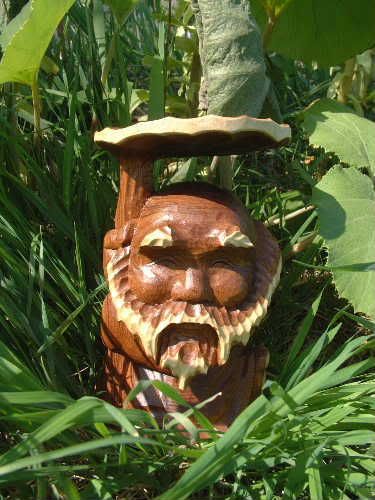
The tiny people were renowned for their expert skill in hunting, fishing, trapping deer, and other such activities. They were allies with the Ainu people and would share their stocks with them, but since they were extremely shy and hated to be seen by humans, they would only steal out from under the plants in the dead of night and leave the goods on windowsills and near doorways. One night, a young Ainu man decided that he wanted to witness the Korpokkur people for himself, so he hid near his window in order to catch a glimpse of them. As one Korpokkur drew near to him, he grabbed it by the arm and pulled it into his home in order to get a good look.

Unfortunately for him, the one in question was a beautiful young Korpokkur woman, who was so offended by this bold showing, that the Korpokkur people disappeared from under their leaves and never returned to trade or share with the Ainu ever again. It is said that, when the young man grabbed the Korpokkur girl's arm, he noticed an intricate patternwork of markings there, and this is the inspiration for the woven arm tattoos that Ainu women have.
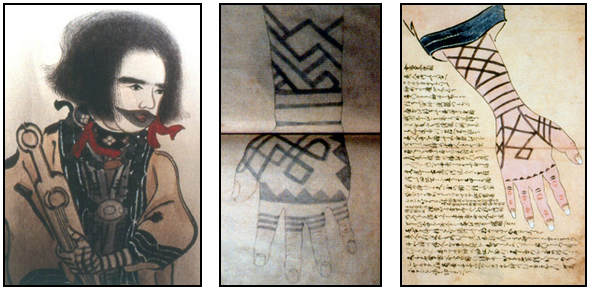
According to the folklore, many tools and the remainder of the Korpokkur homes that they abandoned when they left the Ainu people are still there under the leaves to this day. I remember being very small and going on a class trip, but for some reason we couldn't go into the nature walk right away, so we had to sit outside the entrance to the trail. In order to get us to shut up, I suppose, our guide took us to a small area where there were some smaller leaves growing, and explained to us that the little people who used to live under them had become afraid of all of the people and fled so quickly, that they had still left their food cooking in their homes, and if we each picked a leaf and smelled under it, we might be able to figure out what had been cooking at the time. Everybody said that they smelled a different type of food from the same leaf, and obviously this story is adapted from the Korpokkur legend.

A drawing of the Korpokkur people.
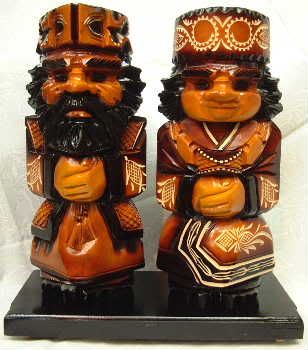
Some traditionally crafted wooden Korpokkur dolls.
Variants of the Korpokkur dwarfs appear in many modern-day pop-culture settings. For example, the little guys who help you with your farm in Harvest Moon are Korpokkur.

Also here in Zelda,

and in Ōkami.
The next performance also takes place in Hokkaido, so another legendary figure from Ainu folklore is used. This time is is the Pawci (パウチカムイ, Pawci Kamuy, meaing "Pawci God"). The Pawci is the Ainu god of lustful insanity. I couldn't find any good pictures of the Pawci, so instead I'll just share some folk tales I know about it. These legends get pretty graphic, so be warned.
Though technically considered a kamuy, an Ainu deity, the Pawci is treated with reverence though it is believed to be evil or manipulative towards humans. He is likened to an incubus or succubus, appearing to young people (generally, as in a morality story, though variations have him inflicting his insanity on anyone and everyone), he causes them to go mad in the torturous form of pain, stong sadness and emotion or disregard for right and honor in the world. But this is rare. The most common and dangerous way the Pawci will inflict you will just be to make you a sexual deviant.
Anywhere from people finding themselves unable to keep their clothes on and taken to whimsical lewd dancing, excessive loudness, interrupting or shouting, obscenity, cheating on your husband or wife, or being in a constant state of horniness, culminating in wild sex or a public orgy. Even the Ainu word for orgy, as well as many sayings pertaining to sex in the culture, are derived from or in reference to the Pawci Kamuy. The only way to escape this insanity would be through a ritual inflicting a great amount of pain and bloodshed on you, or perhaps a sentence to go work in the woods on the mountains, in a hope that through the strenuous activity and constant prayer, the Pawci would flee up the mountain and leave you alone.
Another legend accredited to the Pawci is that of masago. Masago is the sweet orange roe, aka little fish eggs, that you see sprinkled all around Japanese cuisine, or often in sushi form, accompanying other flavors or simply by itself.
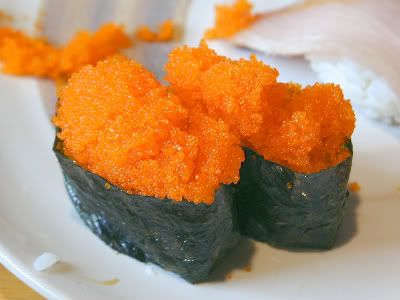
It is believed that the Pawci live at the top of the River of Heaven, Shushurampet. Many people cannot go there, but occasionally some lesser gods or shaman who have passed on will gather there. Inflicted by the Pawci, they all began their obscene dance, baring their genitals and showing them to one another. The rapid movement of their genitalia inadvertently tore some leaves from the willows lining the Holy River, which fell into the water. As the leaves drifted down the stream, they became capelin fish, which swam down the river so far that it reached the portion on Earth inhabited by humans. The people ate these fish and the roe because it came from the shores of the River of Heaven, and it is believed that this legend became more widespread, which accredits with the popular eating of masago to this day. Tasty.
My favorite story deals with the Shaman Priestess once again, who is often popping up in the stories of the Pawci, perhaps acting as his acolyte or simply possessed by the madness.
It seems that one day three brothers decided to go fishing on the river. They got into their boat and began their work, so eventually the eldest brother was left in the boat while the younger two walked along the shore looking for fish. The youngest brother suddenly stopped, hearing the sound of a young woman singing. She appeared beside him suddenly, nude and dancing along the riverbank as she sang. She then began making inappropriate gestures implying that she wanted to tongue kiss him. Thinking her to be a goddess or priestess from a neighboring village performing a ritual (or perhaps just being a young man seeing a naked lady trying to make out with him), the boy decided that it would be for the good of their village to try to form alliances (???), and kissed her. She began to suck on his tongue, until her sharp teeth bit it clean off and held it in her mouth as the boy fainted.
Later along the bank, the second eldest brother was looking for fish, and heard the woman singing and saw her dancing naked and making the gestures. He had the same thought as his younger brother (for the sake of the village! Yeah right.), and kissed her, but this time as she bit his tongue out of his mouth, he fell to the ground and died.
Around this time, the eldest brother was sitting in the boat and wondering what was taking his siblings so long. On the shore he saw the naked woman dance over and call to him, sticking her tongue out and begging him to come closer. The man called to her that he couldn't hear her, and had work to do, and she danced away. After a moment, he quietly began following her direction in the boat, before he came upon a small house near the river that seemed to be a fisherman's lodge. As he drew near, he could smell the overpowering stench of blood and decaying flesh coming from inside. Much like the story of the mountain hag, inside the man found many heads, including those of his brothers. arranged on the floor, and above them hanging from the rafters, their tongues were being dried. He took their tongues and put them back in their mouths, and with a snap, they went back into place and re-attached themselves to their bodies. The three brothers then quickly escaped from the clutches of the Pawci witch.
So, Kagrra, reminds us that the Pawci seems to be all about fervent, genital-exposed dancing. You might want to avoid this show.
For the next performance, we travel away from the place of Ainu legend and back into good old-fashioned yōkai territory. This one is one of my favourites, the Tofu-Kozo (豆腐小僧, "Tofu Kid"). Kozo, which can mean "little boy" as well as "young priest", takes its name from the appearance of the yōkai, a little monk in training, often bald and wearing a straw hat, dressed in traditional clothing. He also bears a tray holding a block of tofu.
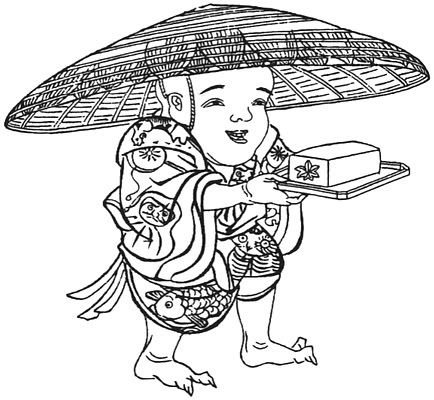
There is a "good" Tofu-Kozo and a "bad" Tofu-Kozo, according to the folklore (which are attributed to children's ghost story books from the Edo period, and not exactly a legendary monster of Japan). Often seen taking shelter on rainy evenings, the Tofu-Kozo will look up at you and offer you a bite of the perfectly delectable block of tofu he has prepared, garnished temptingly with a bright red maple leaf.

Generally you'd think "Bad sign!" and walk away, leaving a sad little monk-in-training in your wake. Good Tofu-Kozo is only wanting to share, and after the nice snack, will send you on your way with a smile and a wave before disappearing. Unfortunately, Bad Tofu-Kozo preys on that sense of guilt of being rude to a little boy, and that's where they get you. He'll say that he's afraid of monsters getting him, which is why he's stopped, and he doesn't want to spoil the tofu by walking home with it in the rain. Eat it for him so that he can head home, and you'll find yourself doubled over in pain, your stomach rebelling against you, or a virus quickly spreading through your entire body, until your eventual horrible death. It's thought that perhaps bad Tofu-Kozo is a human disguise for evil tanuki or kitsune, but I liken him to the droves of mischievous little boy yōkai, since they're pretty common and it seems more like that type of M.O. Some stories say that only the tofu decorated with the red leaves belong to bad Tofu-Kozo, while the rest are good. Me, I wouldn't risk it, however.

Tofu-Kozo from the Kyoka Hyaku Monogatari.
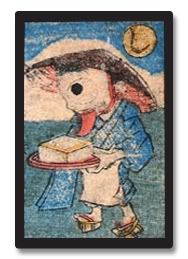
The Tofu-Kozo's karuta, also read as hitotsume-kozo, "one-eyed boy", the stories of which are swapped between them and Tofu-Kozo so that they're basically the same, just a Tofu-Kozo with one eye for instance.

A Tofu-Kozo on Mizuki's Yōkai Road.

The next stop is Saitama, so a local yōkai from Saitama is of course the bakemono du jour. This one is called Sodehiki-Kozo (袖引小僧, the Sleeve-Pulling Boy). Though they are also occasionally known to be female, the manner of it's "haunt" loops it into the aforementioned mischievous little boy yōkai like the Tofu-Kozo.
As you can guess by it's name, Sodehiki-Kozo tugs on people's sleeves. That's all. It's thought to wait in a certain place, perhaps even in a pair or a small group of them, and, during times when a lot of people are walking to or from home and work, they'll run out and tug on their sleeves, and if the person falls for it and stops to look back, they laugh maniacally and run back to where they were standing in order to do it all over again.
Described by Mizuki Shigeru as little black pig-looking creatures, Sodehiki-Kozo are invisible, so it's not known for sure what one really looks like. Since they can't be seen, and are running around tugging on people, often the people won't stop to look, so the Sodehiki-Kozo will touch their bare arm or wrist and tug even harder in order to get the person to pause and look/feel foolish.

A representation of Mizuki's idea of a Sodehiki-Kozo, as shown on his Yōkai Road.
Returning once more to the popularity of Jizo, another tale relates the idea of the Sodehiki-Kozo frequenting shrines or areas in which Jizo statues are kept to watch over children. When a grieving parent leans down to pray or think of their deceased child, a Sodehiki-Kozo nearby will tug on their sleeve, though instead of for pranks, it is believed that they do this either to make the parent remember their child and feel their presence with them in order to cope, or perhaps that since the Sodehiki-Kozo are also children, they are passing on a message to the parents from their children that they are doing OK and are grateful for their concern.
The next being represented is the Onyudo (大入道, "Giant Priest"), who has much in common with a lot of the yōkai I've told you about in this entry and the previous one.
Appearing often as a priest or monk, the Onyudo can either be human size or much taller, growing taller still with his ability to change his height into an enormous size at will. The common expression is that he will grow to an enormous size faster than you can look up at him. Since he can shape-shift, he is linked with the tanuki and kitsune who also shape-shift to play tricks on unsuspecting humans, but the varying stories and activities the Onyudo takes part in really make it into a yōkai all its own, with its own method of doing things.
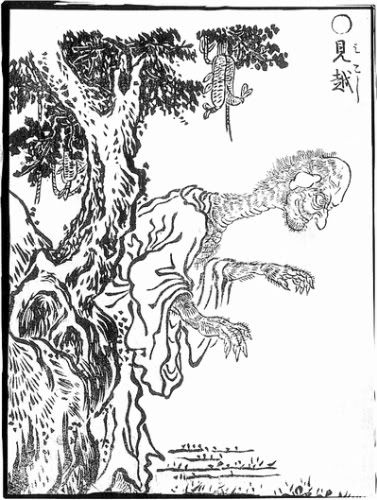
Sometimes he is compared to or thought of as a male Rokuro-Kubi, who grows by extending his neck and lives off of lamp oil and/or human essence. He also can have anywhere between one and five eyes, like the Hitotsume-Kozo's link with the Tofu-Kozo.
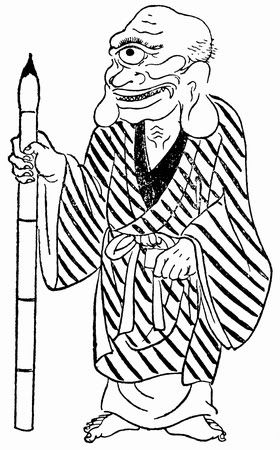
The general consensus, however, is that he can appear as a giant, or as a tall man and grow quickly in order to frighten people. "Evil" Onyudo can be ill omens, arriving to signify bad news is heading your way. These evil Onyudo can also apparently kill you by looking at you, in order to exact revenge immediately, instead of just warning you about it. They also can have horrifically bad breath, which can choke you, or from the sheer force of it, blow you away.
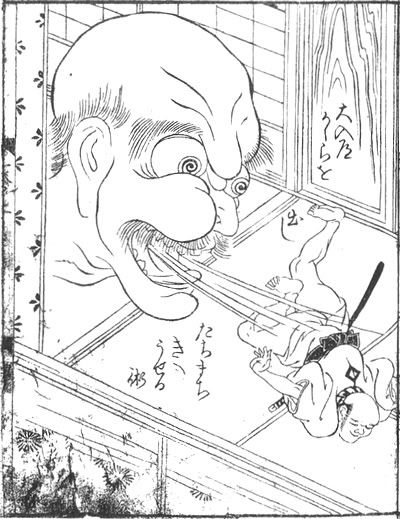
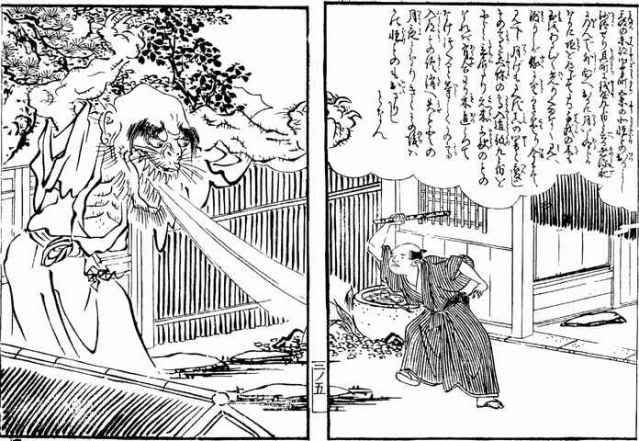
They also like to just chase you around sometimes.
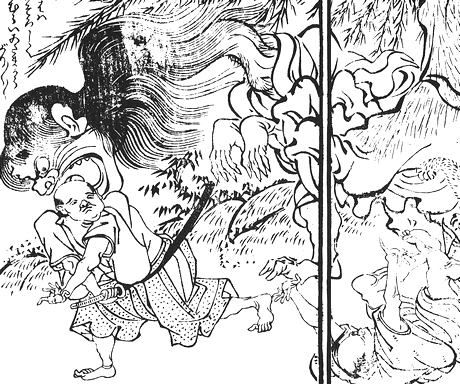

Good Onyudo are much fewer and farther between, but they will use their size to help you in any way they can, often with your work in the fields or something, which they will take care of for you and want nothing in return other than to be left alone and for nobody to see them. If an Onyudo is working in the field and people start gathering to watch it, the Onyudo will either disappear, or stop until they leave, sometimes giving them a withering look with its not-lethal-but-still-creepy googly eyes.
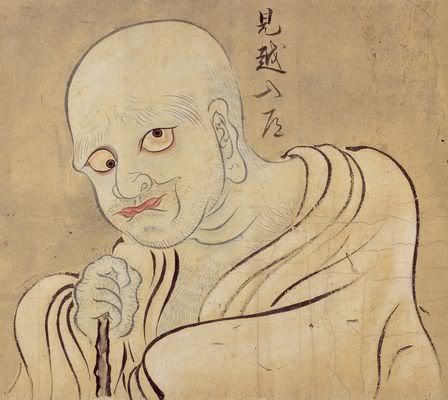
There's even a huge mechanical doll of the Onyudo in Mie Prefecture, which stands at almost 30 feet tall, complete with extending head, blinking eyes, lolling tongue and even waving its arms and legs at you.
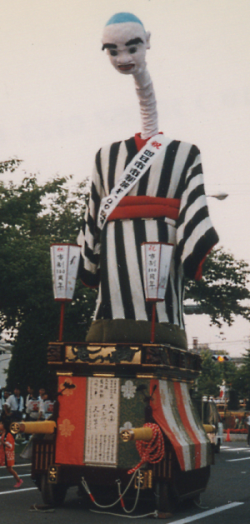
Here's a video of him in action!

Onyudo's Karuta.
The next live takes place in Osaka, and the next yōkai hails from Ibaraki, Osaka, and is fittingly known as Ibaraki-Douji (茨 木童子, "Little Boy from Ibaraki", or sometimes "Ibaraki Demon"). In some legends, it has him as the son of Masakado, from the Tsuchigumo kabuki et al., and others still place him as a form of the Rashomon Demon. The most popular tale, however, is as follows:
After an abnormally long and painful pregnancy, a woman gave birth to a child in Ibaraki (or, in Kyoto, where he was smuggled to Ibaraki to avoid persecution for being of a noble family that was now exiled) who was able to walk from birth, and already possessed a mouth full of teeth. The mother died in childbirth, or perhaps out of shock at seeing the child, and the father, thinking the baby a demon, gave him to the childless barber to raise. The barber did his best to care for the boy, and, since he was already so intelligent at this young age, trained him in the ways of his work to help out around the shop. One day, the little boy was in charge of shaving the head of a customer, and accidentally slipped and nicked the man. Getting the blood on his hand, the boy quickly licked it off of his fingers and finished the job so that he wouldn't get into trouble. He then realized that he quite enjoyed the taste of blood and began to purposefully cut his clients so that he could have some.
Word spread throughout the city, and nobody would come to the barber shop anymore for fear of the blood-drinking child. The barber grew angry and showed the boy the empty shop, shouting at him "Nobody is coming and we will lose the business because of you!" The boy became upset and ran out, going to the river to wash the tears off of his dirty face. As he leaned over the river, he saw the face of a demon reflected in the water, instead of his face! He became scared and fled to the mountains, or some say to Kyoto, where he wreaked demonic havoc.
Ibaraki-Douji is sometimes seen as good luck and strong cultural significance, however, and is included in many of the festivals and rituals, as well as acting as a sort of mascot for the area, appearing at events and gatherings or on signs or in commercials, etc.
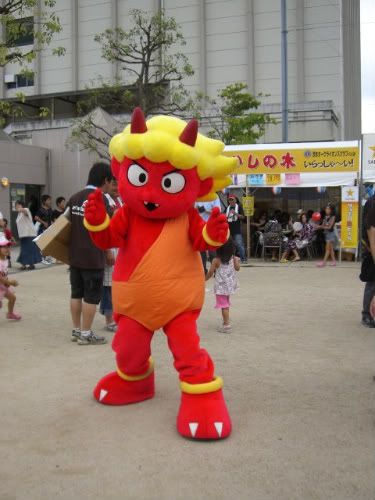
Described as being oni-like, with the trademark red skin and animal hide loincloth, he has long hair which blows around even without wind, fangs, and strength enough to easily overpower a grown man.
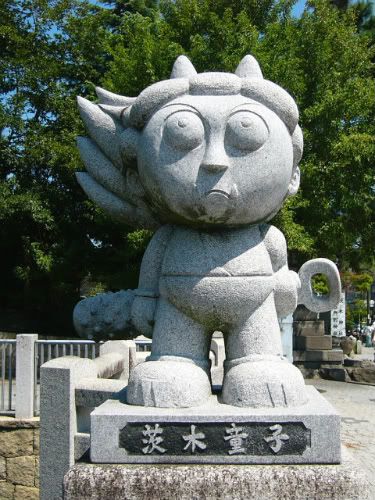
Here he is on the Yōkai Road.
Next we travel to Fukuoka, the seaside home of the Amagoze (海御前, "Lady of the Ocean" or "Sea Spirit"), related to, or portrayed as a vassal of, the Kappa.
The origins of this story, like the Nue's, date back to the Heike Monogatari. The Battle of Dan-no-Ura, which took place in the region around Fukuoka, was fought between the Taira and the Minamoto. The Taira were familiar with the area, and known for their expertise in battles at sea, so, despite the fact that they were outnumbered by the Minamoto, who were being led by the extremely famous general Minamoto no Yoshitsune, they weren't worried. Basically everything went wrong for them in this battle, as one of the Taira generals defected, and told the Minamoto which ship the Emperor (who was only a small child) was on. As the Minamoto launched the attack against the young Emperor's ship, many of the Taira, knowing this battle, which should have been a sure thing, was lost dishonourably, threw themselves overboard to die.
Along with them, the wife of one of the warlords, who had been watching from the shore, followed suit at the disgrace, and threw herself into the sea to drown. Several days later, her body floated back to the shore, smiling contentedly and glowing. Because of her sacrifice, it is said that she became a powerful presence in the sea, and was allowed to rule there among the Kappa and the souls of her fallen people. She is in charge of collecting sea cucumbers for the Kappa to eat, and watches the banks to tell them if any children or animals come near enough for a Kappa to grab and pull into the water. She also will pluck any white soba flowers she comes across, since these represent the crest of the Minamoto, and she doesn't want them near her.
A statue of the Amagoze.
The next stop is in Kyoto, which, as you know, was the site of all the glorious excess and flamboyant traditions of ! THE HEIAN PERIOD !
Naturally, Kagrra, has chose a fitting yōkai for the situation as well. Known as Rashomon no Oni (羅城門の鬼, "the Demon of Rashomon"), Rashomon no Oni is said to be either the demonic vengeance of a man/general/enemy of the Heian Capital who died, simply a demon who chose to feed off of the many people bustling about there, or even as the adult form of the Ibaraki-Douji, whom it shares many stories with because of the associations. Rashomon no Oni has its own specific appearance and legends, however, so it's generally thought of as its own brand of yōkai.
Most of you probably have heard of the Rashomon, and associate it with the famous Kurosawa film of the same name. In fact, it is titled after the short story where some of the plot of the film is taken from, and the Rashomon itself was the extremely decadent gate to the equally decadent Heian Capital, now known as Kyoto.
As the Heian period drew to a close, the gate became run-down and fell into a state of disrepair, reflecting the sunset of the Heian Capital and lifestyle. The gate itself became a notorious meeting place for general unsavory types, and it's not too far of a stretch to imagine the legend of the demon dwelling in the Rashomon an allegory for them, inspiring the stories. The film features a ruined Rashomon, where the characters gather at the beginning, wary of the happenings the place is known for.
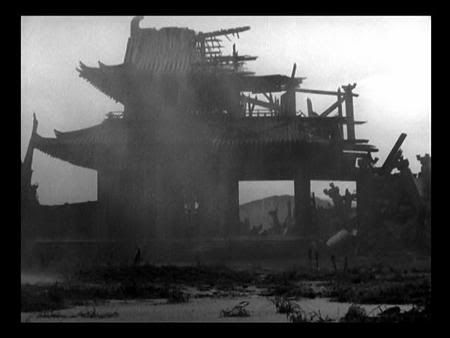
The Rashomon no Oni story itself draws from more tales from Heike Monogatari, and is famously told in a notable kabuki, titled "Ibaraki". Like the Tsuchigumo, the Rashomon no Oni has a brush with one of the Shitennou (four guardians) of Minamoto no Raiko.
The story goes that, as people would enter the city through the Rashomon, they would be hit by a violent wind, or their horses would go wild or else suddenly stop, or, in some tellings, people would simply disappear. One warrior, as he crossed under the gate, saw in his helmet the reflection of a demon looking down at him.

When told of this, Minamoto no Raiko sent his retainer Watanabe no Tsuna to kill the demon. Watanabe no Tsuna did as he was told, and despite his capabilities as a warrior, the demon proved elusive and Watanabe was only able to cut off the demon's left arm with his sword.

As the demon fled, Watanabe no Tsuna kept the arm and sought advice from a priest, who told him that the demon would return to claim its arm within the week. He instructed Watanabe to lock himself in his home, store the arm in a safe box, and pray heavily, taking no visitors or contact with the outside world, so that the arm would be exorcised and the demon would be unable to return.
In the kabuki, the story begins with Watanabe no Tsuna locked up in his house, where a very old woman arrives, exhausted from her long travel to the Capital from a faraway province. As she reaches the entrance to his home, she is denied and told to leave. The old woman grows very upset and explains that she is Watanabe no Tsuna's nanny (or sometimes his aunt) from childhood, who had cared for him for so long, giving up her life and family in order to raise him as her own. Watanabe no Tsuna, unable to turn a blind eye to this woman, allows her to come in and throws a banquet in her honour. Much praise is heaped onto Watanabe for his recent battle with the demon, and his nanny asks him to tell her the story. Watanabe no Tsuna explains that he had fought fiercely, and managed to sever one of the demon's limbs, which he had been instructed to keep safe in a box here in his home. The elderly woman asks to see the demon's arm, and Watanabe agrees, though he orders his men to remain outside so that they will not be exposed to the evil. He takes the old woman into his chambers and shows her the box.
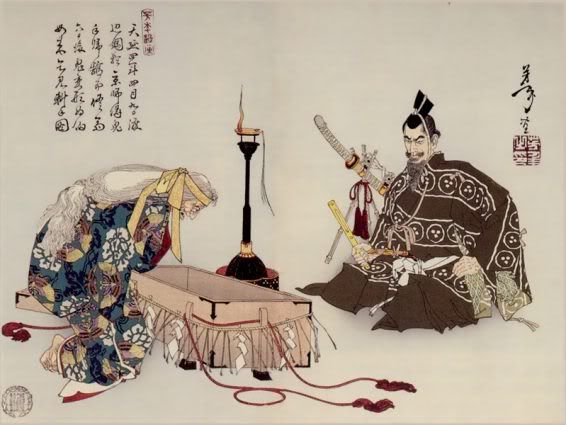
Of course, as she gazes upon the demon's arm, her face and even her body begin to change, altering until it is revealed that she is actually the Rashomon no Oni in disguise. The demon quickly grabs its lost limb and flies off into the night.
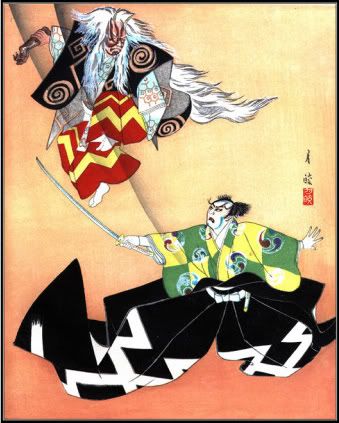
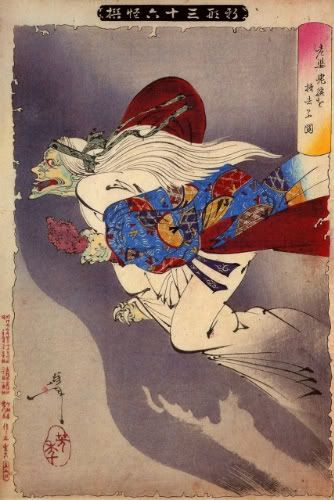
The old woman flies away in this print by Yoshitoshi.
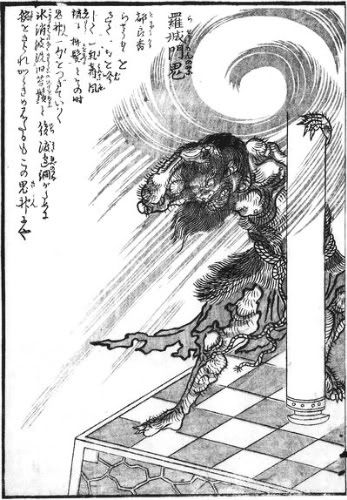
Sekien's Rashomon no Oni.
At last, the final stop on Kagrra,'s Pilgrimage ends in Nagano, which is Isshi's home prefecture. This yōkai also is from Nagano. Known as the Hachimendaioh (八面大王, "Great King with Eight Faces"), he is said to have been a giant beast who lived on Mount Ariake in Azumino. There are many tales about him, but the most popular one bears resemblance to the kabuki "Orochi", as well as parts of that legend.
It seems that Hachimendaioh lived here overlooking a village, where he threatened them greatly. The villagers knew stories of what had happened in the past when someone rebelled against him, and it was said that he was impossible to slay. Hachimendaioh struck a deal with the villagers that he would not eat them if they provided him with a sacrifice of his choosing once a year. Really having no choice in the matter, the villagers reluctantly agreed.
This went on for several years, until one year in particular where he selected as his sacrifice the most beautiful girl in the village. In some tellings, he kidnaps her while she is picking herbs on the mountain. Regardless, the villagers begged Hachimendaioh to return her safely and not kill her or force her to live as his bride. Hachimendaioh gave a great laugh and declared that, try as they might, he could not be killed by any man they sent at him, and holed up in a cave in the mountain.
The villagers were at a loss for what to do, but the Village Leader (who also acted as their priest) came up with a desperate plan in order to get the young woman back and kill the Hachimendaioh once and for all. The Village Leader took a single arrow and blessed it, asking its aim to be true and able to slay the great monster with one strike. He then gave this holy arrow to his youngest son, and explained the difficult task that he was forced to give the child. The little boy summoned all of his bravery and went to the mountain, aiming his bow as best as he had been taught in the few moments of preparation he had been allotted.

The Hachimendaioh's omen proved right, for none of the men could ever have been able to kill him, only the innocence and trust of the little boy, upon whom the hope of the village had rested. The arrow killed him and the boy was able to save the girl, and the two of them were said to have grown into the most capable and just of all the Village Elders.
There are many locations around Nagano that feature shrines, artifacts and stories where Hachimendaioh is said to be buried. There is even a representation of him at a famous hot springs in the area, which features the eight faces looking all around.

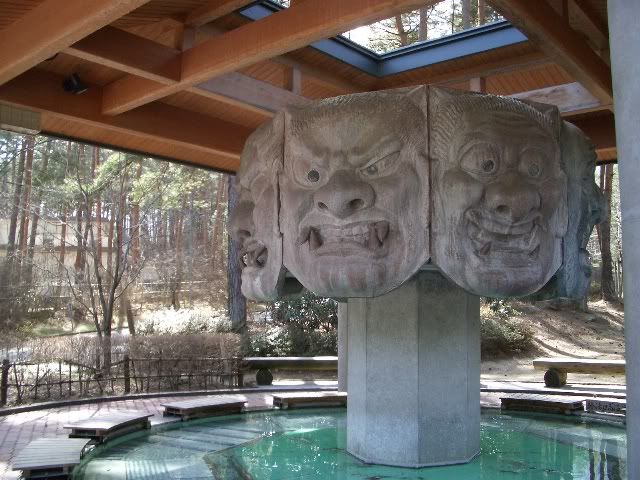
So that's basically a lot more than you'd ever need to know about all of the yōkai Kagrra, have selected as titles along their tour. Look for all of these and more to make appearances as their Hyakkiyakou continues, which I'm sure they and also most likely me will ramble on about when the situation arises.
Also coming up, I plan on doing another Kagrra, entry that will answer some frequently asked questions about them, as well as explain some of the basics about the band that may not be well-known and help to shed some light on common themes and such featured in their music, videos, photoshoots, etc. If you have a question about Kagrra, please feel free to leave a comment, and I'll try my best to answer it in that upcoming entry!
Thanks for reading!
No comments:
Post a Comment